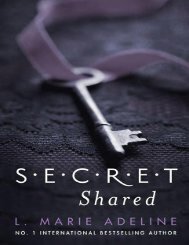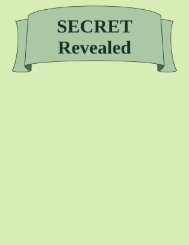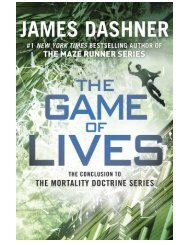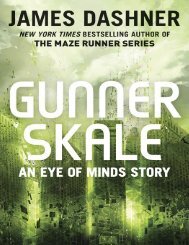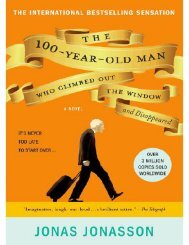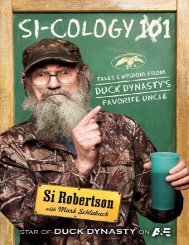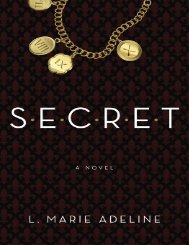32896589326509350
Create successful ePaper yourself
Turn your PDF publications into a flip-book with our unique Google optimized e-Paper software.
window into both the powers and the limitations of the early visual system.<br />
Arthur S. saw musical notation of fanciful elaboration, far more ornate than any real<br />
score. CBS hallucinations are often fanciful or fantastical. Why should Rosalie, a blind<br />
old woman in the Bronx, see gures in “Eastern dress”? This strong disposition to the<br />
exotic, for reasons we do not yet understand, is characteristic of CBS, and it would be<br />
fascinating to see whether this varies in dierent cultures. These strange, sometimes<br />
surreal images, of boxes or birds perched atop people’s heads or owers coming out of<br />
their cheeks, make one wonder whether what is occurring is a sort of neurological<br />
mistake, a simultaneous activation of dierent brain areas, producing an involuntary,<br />
incongruous collision or conflation.<br />
The images of CBS are more stereotyped than those of dreams and at the same time<br />
less intelligible, less meaningful. When Lullin’s notebook, lost for a century and a half,<br />
resurfaced and was published in a psychology journal in 1902 (just two years after<br />
Freud’s Interpretation of Dreams), some wondered whether the hallucinations of CBS<br />
might aord, as Freud felt dreams did, “a royal road” to the unconscious. But attempts<br />
at “interpreting” CBS hallucinations in this sense bore no fruit. People with CBS had<br />
their own psychodynamics, of course, like everyone else, but it became apparent that<br />
little beyond the obvious was to be gained from analyzing their hallucinations. A<br />
religious person might hallucinate praying hands, among other things, or a musician<br />
might hallucinate musical notation, but these images scarcely yielded insights into the<br />
unconscious wishes, needs, or conflicts of the person.<br />
Dreams are neurological as well as psychological phenomena, but very unlike CBS<br />
hallucinations. Dreamers are wholly enveloped in their dreams, and usually active<br />
participants in them, whereas people with CBS retain their normal, critical waking<br />
consciousness. CBS hallucinations, even though they are projected into external space,<br />
are marked by a lack of interaction; they are always silent and neutral—they rarely<br />
convey or evoke any emotion. They are conned to the visual, without sound, smell, or<br />
tactile sensation. They are remote, like images on a cinema screen in a theater one has<br />
chanced to walk into. The theater is in one’s own mind, and yet the hallucinations seem<br />
to have little to do with one in any deeply personal sense.<br />
O<br />
ne of the dening characteristics of Charles Bonnet hallucinations is the preservation<br />
of insight, the realization that a hallucination is not real. People with CBS are<br />
occasionally deceived by a hallucination, especially if it is plausible or contextually<br />
appropriate. But such mistakes are quickly realized to be such, and insight is restored.<br />
The hallucinations of CBS almost never lead to persistent false ideas or delusions.<br />
The ability to evaluate one’s perceptions or hallucinations, however, may be<br />
compromised if there are other underlying problems in the brain, especially those which<br />
impair the frontal lobes, since the frontal lobes are the seat of judgment and selfevaluation.<br />
This may happen transiently, for example, with a stroke or head injury;<br />
fever or delirium; various medications, toxins, or metabolic imbalances; dehydration or<br />
lack of sleep. In such cases, insight will return as soon as cerebral function returns to



